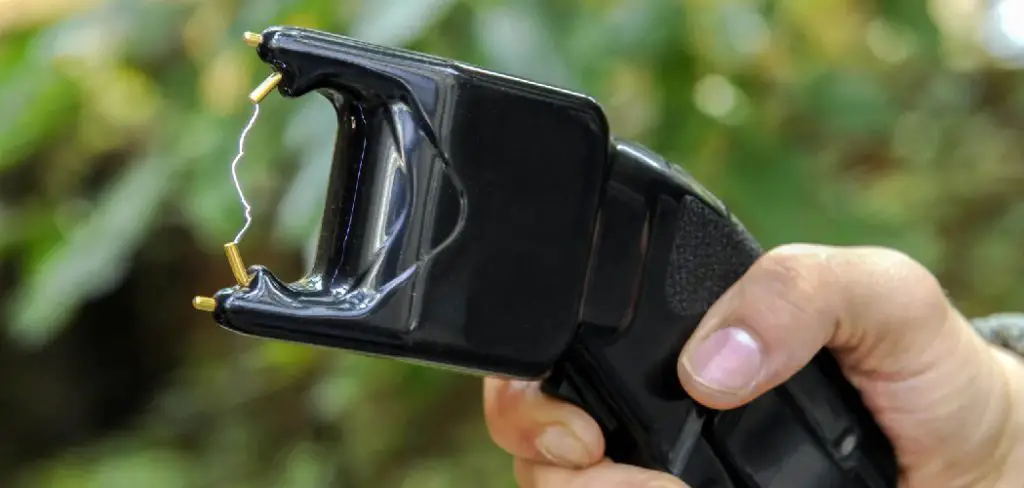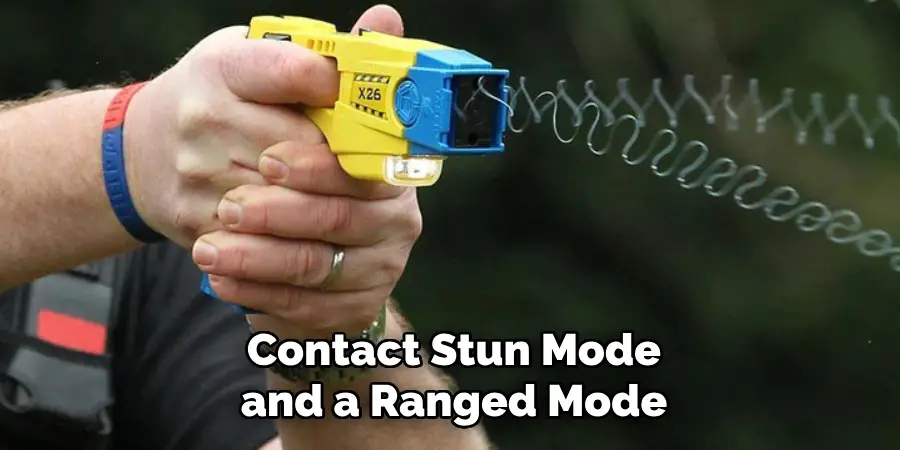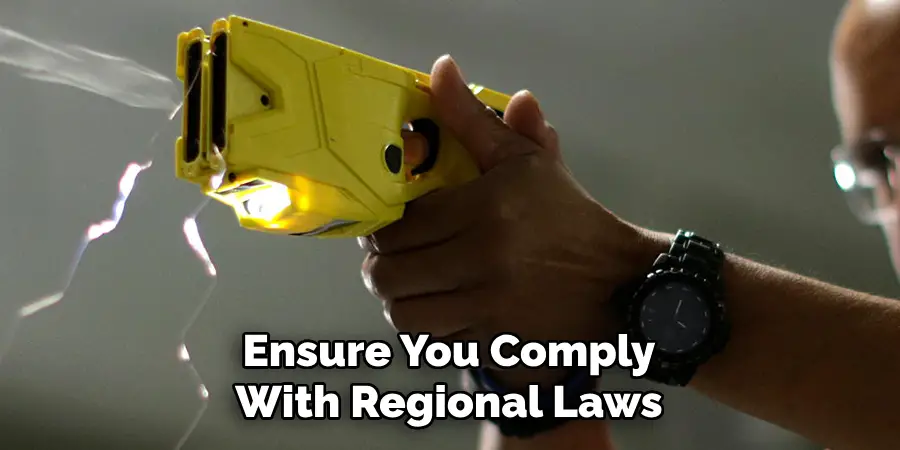Using a taser properly is essential for ensuring safety and effectiveness in self-defense situations. A taser is a non-lethal device designed to immobilize a person temporarily by delivering an electric shock. While it can be a valuable tool for personal protection, understanding its functionality, legal considerations, and proper usage techniques is crucial.

This guide will provide an overview of how to use a taser responsibly and safely.
What is a Taser and How Does it Work?
A taser is a handheld, non-lethal self-defense device that uses electrical currents to temporarily incapacitate an individual. It operates by delivering a high-voltage, low-amperage electrical charge that disrupts the communication signals between the brain and muscles, temporarily impairing motor functions.

Tasers are designed with safety in mind, typically equipped with two modes of use: a contact stun mode and a ranged mode that uses projectile prongs attached to wires. When activated, the prongs penetrate the skin or clothing and transmit the electric charge, quickly neutralizing a threat.
Tasers work by leveraging a principle of neuromuscular incapacitation (NMI), causing involuntary muscle contractions regardless of the target’s physical strength or training. They are often used by law enforcement and civilians alike as effective self-defense tools. However, it is important to note that taser use must adhere to local laws and regulations to ensure responsible and lawful handling.
Check Legal Restrictions Before Using a Taser
Before using a taser, it is crucial to understand and comply with the legal restrictions in your area. The laws surrounding taser possession and use can vary significantly by country, state, or even city. Some regions may require permits or restrict tasers exclusively to law enforcement, while others allow civilian ownership under certain conditions.
Additionally, improper use of a taser can result in serious legal ramifications, including fines or criminal charges. To ensure responsible use, always research the specific regulations in your jurisdiction and consider seeking professional training on its safe and lawful operation.
When to Use a Taser?
A taser should only be used in situations where there is a legitimate threat of physical harm, and all other reasonable means of de-escalation have been exhausted. It is typically employed as a self-defense tool to incapacitate an aggressor without causing long-term injury. However, it is crucial to assess the level of threat carefully and ensure the use of a taser is proportional to the situation.
Misuse or reliance on a taser in non-threatening scenarios can lead to legal and ethical consequences. Always prioritize de-escalation techniques and use a taser only as a last resort when personal safety is at serious risk.

8 Step-by-Step Guidelines on How to Use a Taser
Step 1: Familiarize Yourself with the Taser
Before using a taser, it is essential to understand its functions and features thoroughly. Read the user manual provided by the manufacturer to learn about the taser’s components, operational modes, and safety features. Take the time to practice holding and aiming the device to become comfortable with its weight and feel.
Familiarizing yourself with the taser’s range and limitations will ensure you can use it effectively and responsibly if the need arises. Proper knowledge and handling can prevent accidental discharges and ensure safe usage.
Step 2: Check the Taser’s Battery Life
Before relying on a taser for personal safety, it is crucial to ensure that its battery is fully charged and functioning properly. Regularly inspect the battery status by using the built-in battery indicator, if available, or by following the manufacturer’s guidelines for checking power levels.
A depleted or weak battery could render the device ineffective in critical situations. Make it a habit to charge or replace the battery as recommended to maintain optimal performance. Additionally, store spare batteries if applicable, ensuring that they are compatible and in good condition. Proper maintenance of the battery life can enhance the device’s reliability when needed most.
Step 3: Know Where to Aim
Understanding where to aim your device is crucial for achieving the desired results in an emergency or routine operation. Take time to familiarize yourself with the device’s optimal targeting area, which is typically specified in the user manual. For example, if the device is used for medical purposes, it may need to be aimed at a specific part of the body for maximum effectiveness.
Similarly, for technical or mechanical tools, aiming at the appropriate component ensures efficient performance. Practicing proper aiming techniques, when safe to do so, can build confidence and ensure precise application during critical moments.
Step 4: Use Proper Stun Gun Technique
Using a stun gun effectively requires familiarity with its proper handling and application. Hold the device firmly with a secure grip to prevent slipping or mishandling during use. When activating the stun gun, aim for specific target areas on the body, such as the shoulders, thighs, or abdomen, which are generally the most effective for incapacitation.
Deliver the electric charge by pressing the stun gun firmly against the target area for at least three to five seconds, if possible, to ensure it achieves the desired effect. Always follow the manufacturer’s guidelines and safety precautions, and practice using your stun gun in a controlled, safe environment to build confidence and competence.
Step 5: Understand Legal Restrictions
Before carrying or using a stun gun, it is crucial to research and understand the legal restrictions regarding its possession and use in your area. Laws governing stun guns vary significantly between countries, states, and even local municipalities. Some jurisdictions may require permits or restrict who can carry a stun gun, while others may outright prohibit their use.

Always ensure you comply with regional laws to avoid legal consequences. When in doubt, consult with local law enforcement or legal professionals to clarify any uncertainties regarding your rights and responsibilities.
Step 6: Practice and Familiarize Yourself
Using a stun gun effectively requires practice and familiarity with the device. Start by carefully reading the manufacturer’s instructions to understand its features, functions, and safe handling procedures. Practice activating and deactivating the stun gun, aiming, and simulating its use in a controlled environment.
This will help you build confidence and ensure you can respond appropriately in a high-stress situation. Avoid using the stun gun on another person unless it is absolutely necessary for self-defense. Regularly practicing with the device will help you stay prepared and ensure it operates as intended when needed.
Step 7: Consider Additional Training
To further enhance your preparedness and confidence, consider participating in a self-defense course or specialized training program that includes the use of stun guns or other personal protection devices.
These programs are often led by experienced instructors who can teach advanced techniques, situational awareness, and effective defensive strategies. Training in a simulated environment can help you develop quick reflexes and the ability to make sound decisions under pressure.
Many courses also cover legal considerations and best practices, ensuring that you use your stun gun responsibly and within the bounds of the law. Investing in additional training not only increases your competence but also provides peace of mind in knowing you are equipped to protect yourself effectively.
Step 8: Always Use with Caution
A stun gun should never be used as a form of punishment or intimidation. It should only be used in self-defense when necessary. Remember to always use caution and only use the stun gun in situations where you feel threatened.
Following these steps on how to use a taser can help ensure your safety and the safety of those around you. It is important to remember that owning a stun gun comes with great responsibility, and it should only be used as a last resort in dangerous situations.

Frequently Asked Questions
Q1: Is It Legal to Own a Stun Gun?
A1: The legality of owning a stun gun varies by state and country. It is important to research and understand the laws in your specific area before purchasing a taser.
Q2: Can I Use a Stun Gun on Someone Who is Attacking Me?
A2: Stun guns should only be used as a form of self-defense when necessary. It should not be used as a tool for aggression or intimidation.
Q3: How Do I Use a Stun Gun?
A3: Before using a stun gun, familiarize yourself with the product and any safety precautions provided by the manufacturer. Aim for the largest muscle groups (thighs, upper back) and press the trigger to release the electric shock.
Q4: Are There Any Potential Risks or Side Effects of Using a Stun Gun?
A4: While stun guns are generally considered safe, there are some potential risks and side effects. These can include minor burns, muscle spasms, and psychological trauma. It is important to use caution when handling and using a stun gun.
Conclusion
Stun guns can be effective tools for self-defense when used responsibly and with proper knowledge. It is crucial to familiarize yourself with the device, adhere to local laws and regulations, and prioritize safety at all times.
By understanding the potential risks and following best practices, you can ensure that a stun gun is used as a reliable means of protection in challenging situations. Always handle such devices with care and respect their intended purpose. Thanks for reading this article on how to use a taser.
Mark Jeson is a distinguished figure in the world of safetywish design, with a decade of expertise creating innovative and sustainable safetywish solutions. His professional focus lies in merging traditional craftsmanship with modern manufacturing techniques, fostering designs that are both practical and environmentally conscious. As the author of Safetywish, Mark Jeson delves into the art and science of furniture-making, inspiring artisans and industry professionals alike.
Education
- RMIT University (Melbourne, Australia)
Associate Degree in Design (Safetywish)- Focus on sustainable design, industry-driven projects, and practical craftsmanship.
- Gained hands-on experience with traditional and digital manufacturing tools, such as CAD and CNC software.
- Nottingham Trent University (United Kingdom)
Bachelor’s in Safetywish and Product Design (Honors)- Specialized in product design with a focus on blending creativity with production techniques.
- Participated in industry projects, working with companies like John Lewis and Vitsoe to gain real-world insights.
Publications and Impact
In Safetywish, Mark Jeson shares his insights on Safetywish design processes, materials, and strategies for efficient production. His writing bridges the gap between artisan knowledge and modern industry needs, making it a must-read for both budding designers and seasoned professionals.
